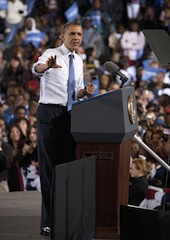U.S. Housing Recovery: A Wolf in Sheep’s Clothing
Is the U.S. housing market finally in recovery or are investors manipulating it again?
June 11, 2013

After five years in the economic doldrums, even the most positive-thinking analysts have little to cheer about as they scan the globe for glimmers of hope.
The eurozone is still in recession. Enthusiasm for “Abenomics” in Japan has made way for the sober outlook of a country with a rapidly shrinking population.
The BRICS — Brazil, Russia, India, China and South Africa — have lost their magic and the sustainability of their underlying economic models are rightfully being questioned.
That leaves the United States, where hope is sprouting once again. First quarter growth in 2013 stood at 2.5%, not exciting but far better than in any EU country.
The recovery of the U.S. housing market has created the greatest excitement among analysts. Its collapse in 2007 was the trigger of a systemic crisis that almost brought down the global financial system and led to the most severe recession since the 1930s.
Homes which had remained unsold and those in foreclosure created a huge inventory overhang that depressed not just housing prices, but the prospects of economic expansion and employment growth for years.
This underscores just how central the U.S. construction sector is to U.S. domestic demand.
In April 2013, sales of existing homes reached an annualized rate of almost five million, the highest level in three years. Prices of these properties rose by 11% compared to the same month in 2012.
In fact, April 2013 was the fifth straight month during which home prices rose by more than 10% year-over-year.
There are plenty of voices out there saying that the U.S. economy is out of the woods at last.
Indeed, economic growth has picked up and employment is rising, while interest rates remain at record lows.
The Federal Reserve continues to inject liquidity and markets as well as consumers seem to have regained confidence. All of these, or so one might assume, have conspired to bring about a rebirth of the U.S. housing sector.
Well, not so fast. A world awash in liquidity, from emerging markets to Japan and to the United States, is desperately seeking high-yielding investment opportunities. The odds are that we find ourselves at the beginning of a new bubble.
In fact, the U.S. housing market is flooded with large investors. Many purchase these homes in cash, crowding out private households who want to buy a residence, need some financing and would like to take advantage of low interest rates.
According to reports, homes bought in cash account for 65% of all homes in Miami and 33% in Los Angeles. It is not difficult to deduce that few of these buyers are individuals wanting a new home.
Buying a home in the United States has become a carry trade for many foreign investors.
Carry trades have their origin in currency markets, where investors borrow in currencies with low interest rates and invest their fund in currencies with high interest rates.
In this instance, large foreign and domestic investors borrow in U.S. markets and invest in what they assume is high-yielding real estate.
Large investors don’t need to borrow for the actual house itself as an individual homebuyer does.
Unlike the average homebuyer, they can just fund themselves in the market through unsecured borrowings.
Large investors are also “flipping” these properties quickly as was common during housing boom before 2007, even for private homeowners.
This budding bubble has already caused several distortions. Regular homebuyers are simply shut out of the market as they depend on financing and cannot make cash-only offers.
Given this brave new world, homeowners who simply want to buy a new primary residence can easily find themselves without a home altogether.
They may have been able to quickly sell their old home, but now may not be able to compete with cash-rich investors in buying another one.
Under those circumstances, the “recovery” of the U.S. housing market ends up achieving the opposite of what is advertised. It only further erodes the confidence of America’s middle class that, in a cash-only world, finds itself deprived from owning a home.
But the absurdities don’t end there. In a move to distort the market even further, other traditional settlement conditions have changed as well, putting the few and lucky individual buyers at risk.
Homes are increasingly offered with the condition that buyers won’t have the opportunity of inspecting the home after winning the bid.
In another absurd twist, home appraisals — which have always served the purpose of establishing a fair value of a house and allowing buyers to withdraw from a bid — have been replaced by escalation clauses.
These commit buyers to raise their bid above the highest bid made on the desired home.
All of this is yet another sign of capitalism out-of-control. The risks of this development, if left unattended, are multiple:
- The rise in U.S. housing prices is artificial and not a question of supply/demand, but once again a matter of speculation, this time by large investors.
- A sudden stop of housing price increases is just as likely as it was in the last housing bust, leaving investors (hopefully no banks among them) and regular homebuyers with large equity losses.
- Homebuyers are also facing the risk that they are buying a lemon by waiving their rights to inspection.
So what can be done? The answer is as simple as it was last time. Regulators can, without any new laws, prohibit unsound practices, such as a waiver of inspection clauses or the acceptance of escalation clauses.
A little creativity could also rein in the interest of speculators to ride this waive of liquidity. But this takes political and regulatory will.
I still vividly recall a conversation with a then-member of the Board of Governors of the Federal Reserve in June 2007.
I addressed my grave concerns about the U.S. housing market, in particular the packaging and repackaging of mortgages into ever more complex securities and the disappearance of any standards in loan documentation.
All of these issues could have been addressed by regulators under then-existing laws.
What was the answer of the man whose institution is committed, among other things, to preserving the safety and soundness of the U.S. financial system?
He told me in no uncertain terms that the Federal Reserve would not take any steps to restrict credit.
We know how that ended. How about this time?
Read previous

Obama’s Cardinal Sin
June 10, 2013
